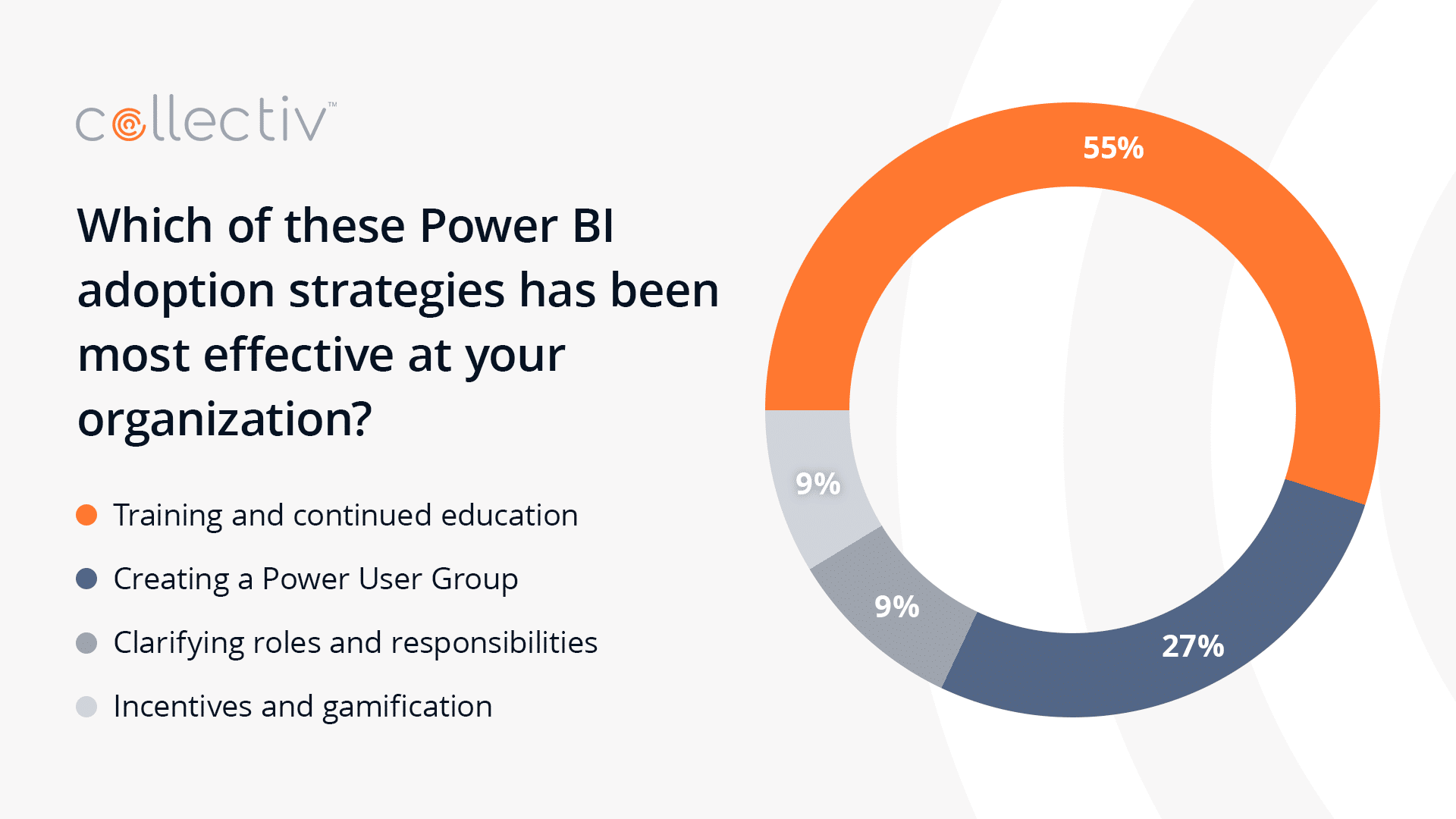Investing in a modern business intelligence solution is the right step towards achieving greater visibility in processes and making impactful business decisions. However, investing in a shiny new BI solution certainly isn’t the only step that will guarantee enterprise success.
To realize the true value of your investment, the people within your organization must be ready to evolve. User adoption is a key metric that demonstrates the success rate of your BI solution. Data tells us that internal success isn’t happening.
Despite the growing number of investments in BI and analytics globally, the adoption rate is around 26%, whereas at larger companies it sits at around 80%.
People have a tendency to resist change. So, how do you help them realize the importance of business intelligence software?
We’ll first identify why your adoption rate is not where it should be. Then, we’ll explore strategies you can implement to improve business intelligence user adoption and ensure enterprise-wide success.
Why Business Intelligence User Adoption is Low
Immense opportunities with data and analytics capabilities convinced you to invest in a modern business intelligence solution, such as Power BI. But others at your organization might not think or feel the same way.
58% of people said their top focus area in 2022 is increasing organizational Power BI adoption. But, adoption continues to be a major roadblock for enterprise teams.
Perhaps other team members have never used business intelligence tools to gain insights. Additionally, they’re busy operating a host of other productivity tools to complete daily tasks and they are set in their ways.
With your new BI tool, you’re adding another step to their work routine. In reality, this isn’t a reasonable proposition because your team doesn’t yet recognize the potential of your solution.
What we see time and time again with the teams we work with at Collectiv is a lack of training being the main cause for low BI adoption. 55% said that continuous training and education is their most effective Power BI adoption strategy. We couldn’t agree more…it’s a big reason why me and my colleagues do so many training sessions with enterprises.
Low business intelligence adoption is inevitable when you neglect the role of people within your processes. You focus on adding unnecessary features rather than understanding what business processes actually require.
These features may give you an edge over your competitors, but your team may not see the value and/or they will struggle to use them. Business intelligence training is key to increasing user adoption.
Situations like these are a common oversight in most enterprises undergoing digital transformation. But, there are several ways to overcome these challenges and ensure better BI adoption rates.
Increase Enterprise Business Intelligence User Adoption
1. Establish a well-defined business use case
Develop a convincing use case highlighting the benefits of your BI solution. Demonstrate how the tool helps various business units achieve goals faster and replace existing technologies and processes.
When every individual understands the tool’s purpose, BI adoption rates will begin to improve. This exercise will also help you select appropriate BI features as you will be able to identify needs and priorities directly from your team members—who all have valuable input to offer during the implementation process.
A good place to start is identifying just one of the reports that someone runs in Excel, then automating that report in Power BI. Once they see how much time Power BI saves them on just one report, they’ll be keener on using the tool. So, show them the whole value statement.
2. Keep your data quality in check
Businesses often overlook data quality when implementing a BI solution. Business intelligence software can only produce insightful results based on high-quality data. If users find a data issue, they will quickly turn their back on the new tool.
Ensuring data quality right from the beginning will encourage users to consider your BI tool as a valid and reliable source of information and reduce their dependencies on disjointed reports or spreadsheets. Having a cohesive data warehouse with a process around it to obtain new data
will help to improve data quality and decrease the margin for error.
3. Select the right BI platform
Take your time and conduct a thorough assessment when selecting a BI solution. While everyone in your organization may have an interest in using a reporting tool, data needs will vary from business unit to business unit.
An ideal enterprise business intelligence platform should be flexible. It brings easy-to-understand data into the tools that team members are already using. BI solutions with embedded analytics support make this possible. Instead of asking people to use another solution to find insights, with embedded analytics, you can integrate dashboards directly so all insights are centralized and accessible.
Having a platform where business users can go to receive all their insights will help to increase adoption. Business users are always seeking a single source of truth.
4. Internal champions and liaisons
Now that you have selected the right BI platform, make sure the right team is in place. The best way to build credibility for your chosen business intelligence software? Validation from people throughout your organization.
To effectively promote business intelligence adoption, you need both champions and liaisons. Your BI team should include a combination of executive leadership, BI champions, and end-users. These individuals will encourage and inspire others to get on board—and be there to offer guidance when questions or concerns arise.
Executive ownership is particularly important, as user adoption will fail unless organizational leaders are driving everything forward. Identifying an executive sponsor that can update the other executives with progress and blockers will enhance the implementation of your BI platform.
5. Continuous training
Training plays an important role in enhancing user adoption rates. A single onboarding training isn’t enough, especially when today’s business intelligence platforms are continually evolving and expanding.
Training should be an ongoing process that works within the unique context of your organization. With continuous learning and a deeper understanding, users will develop more interest in using the tool to meet objectives and advance in their roles.
6. Celebrate small wins and create incentives
Most people are very resistant to change, which is why we talk a lot about change management being a critical piece of an enterprise data strategy. Incentives are extremely helpful with team buy-in, so create incentives for process improvement and learning to motivate business users to use the BI platform.
When any of your business units manage to achieve better results through BI and analytics, make sure to celebrate these victories (no matter how small they seem). Highlight success stories across the organization and let them serve as inspiration for other teams to find their own successes.
____________
At the end of the day, your BI solution will only bring benefits if enough people are willing to use the tool…and maximize its capabilities. Encourage team members to move on from their legacy systems, progress with robust BI solutions, and contribute to your data-driven culture.
The Collectiv team helps enterprise teams like yours improve BI user adoption rapidly. Work with us.






